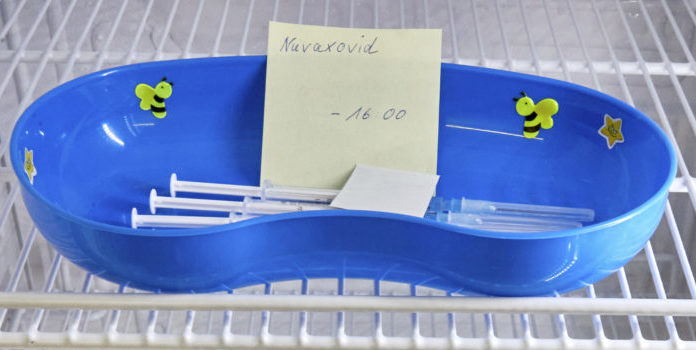(Headline USA) U.S. adults who haven’t gotten any COVID-19 shots yet should consider a new option from Novavax—a more traditional kind of vaccine, health officials said Tuesday.
Regulators authorized the nation’s first so-called protein vaccine against COVID-19 last week, but the final hurdle was a recommendation from the Centers for Disease Control and Prevention.
“If you have been waiting for a COVID-19 vaccine built on a different technology than those previously available, now is the time to join the millions of Americans who have been vaccinated,” CDC Director Rochelle Walensky said in a statement, endorsing an earlier decision from an influential advisory panel.
Most Americans have gotten at least their primary COVID-19 vaccinations by now, but CDC officials said between 26 million and 37 million adults haven’t had a single dose—the population that Novavax, for now, will be targeting.
“We really need to focus on that population,” said CDC adviser Oliver Brooks, past president of the National Medical Association. Hopefully, the vaccine “will change them over from being unvaccinated to vaccinated.”
While it’s unclear how many will be persuaded by a more conventional option, “I’m really positive about this vaccine,” agreed fellow adviser Pablo Sanchez of Ohio State University.
Skepticism has grown due to the Biden administration’s politicization of the vaccines, initially developed during the Trump administration. Several flip-flops and damning admissions by the CDC that it withheld data about the vaccines has only retrenched those attitudes.
However, a emergence of a new subvariant of COVID, which appears to be resistant to the vaccines, is fueling a new push for pandemic alarmism, which may or may not be linked to Democrats’ efforts to undermine election integrity in the 2022 midterm election.
While it is unclear how virulent or lethal the BA.5 strain is—or whether it may be used like omicron to deliver natural immunity to those who contract it with only mild symptoms—some may welcome another, less controversial option in the vaccine market.
Recent research suggests it may be unnecessary for those with type-O blood to get vaccinated due to a natural COVID protection, although other reports have suggested that the vaccines themselves have done more harm than good, particularly the so-called mRNA vaccines, which were not considered to be vaccines in the traditional sense until public health officials revised the meaning of the word.
All of the vaccines used in the U.S. train the body to fight the coronavirus by recognizing its outer coating, the spike protein—and the first three options essentially turn people’s cells into a temporary vaccine factory.
The Pfizer and Moderna vaccines deliver genetic instructions for the body to make copies of the spike protein. The lesser-used Johnson & Johnson option uses a cold virus to deliver those instructions.
In contrast, the Novavax vaccine injects copies of the spike protein that are grown in a lab and packaged into nanoparticles that to the immune system resemble a virus. Another difference: An ingredient called an adjuvant, that’s made from the bark of a South American tree, is added to help rev up that immune response.
Protein vaccines have been used for years to prevent other diseases, including hepatitis B and shingles.
Large studies in the U.S., Mexico and Britain found two doses of the Novavax vaccine were safe and about 90% effective at preventing symptomatic COVID-19.
When the delta variant emerged last summer, Novavax reported a booster dose revved up virus-fighting antibodies that could tackle that mutant.
Typical vaccine reactions were mild, including arm pain and fatigue, but regulators did warn about the possibility of a rare risk, heart inflammation, that also has been seen with the Pfizer and Moderna vaccines, mostly in teen boys or young men.
But early on, manufacturing problems delayed the Novavax vaccine — meaning the shots were studied long before the omicron variant hit, so it’s not clear how well they hold up against the immune-evading mutant.
Still, Novavax points to lab testing that shows the first two shots do spur production of virus-fighting antibodies that are cross-protective against omicron, including the BA.5 subtype that’s currently the nation’s top threat. A booster dose further revved up cross-protective antibodies.
The CDC’s advisers unanimously endorsed the two-shot primary series. But several noted that it was important for regulators to clear a booster by the time, five or so months after their last dose, that Novavax recipients will need one.
Also, the two doses typically are given three weeks apart. But CDC officials said that like with other COVID-19 vaccines, it’s possible to wait up to eight weeks for the second dose—except for people at the highest risk, who need protection quickly.
Walensky signed off on recommendations for adults to get the first two Novavax doses. In its first purchase, the U.S. government bought 3.2 million doses and vaccinations are expected to begin in the next few weeks.
The Novavax vaccine also is used in Europe, Canada, Australia, South Korea and other countries. Many allow booster doses, and European regulators recently cleared the shots to given as young as age 12.
The Maryland-based company likewise expects U.S. authorization of a booster dose and teen vaccinations to follow fairly soon.
And like other vaccine makers, Novavax is testing shots updated to better match the newest omicron subtypes — in anticipation of another round of boosters this fall and winter.
Adapted from reporting by the Associated Press

